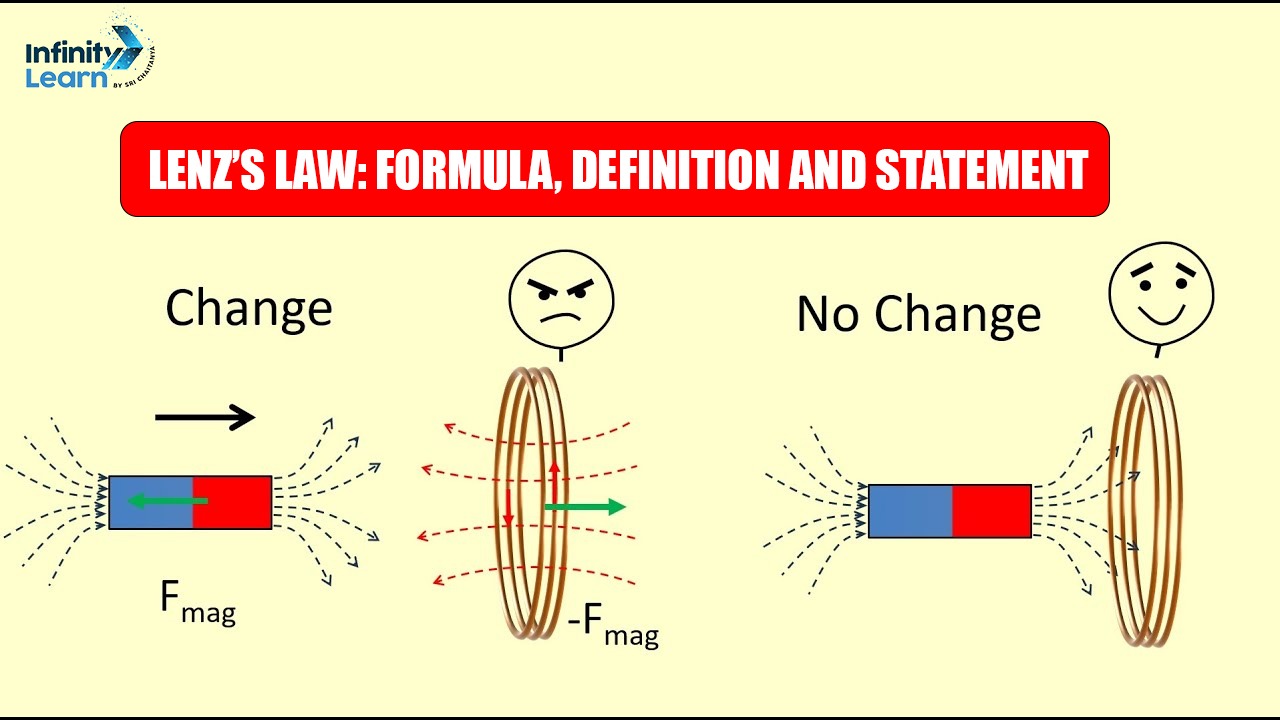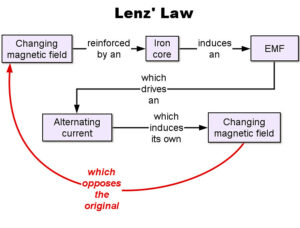Table of Contents
What is Lenz’s law? What is the formula of Lenz’s law? This article will provide with all the required information. Before we get answers to all these questions and others, let us first try to understand electromagnetic induction.
Electromagnetic induction is a highly efficient method of generating energy. It is employed everywhere, from electrical generation to delivery. This is a method of generating voltage or electromotive force across a conductor by altering magnetic flux or magnetic fields. This electromagnetic induction theory was founded on Michael Faraday’s theories and Lenz’s law, which were established in 1830.
Lenz’s law states that: The induced current’s direction is such that it opposes the change that caused it.
Lenz’s law can also be seen in terms of energy conservation. If a current is created by forcing a magnet into a coil, the energy in that current must have come from somewhere. The situation is evident if the induced current creates a magnetic field that opposes the field increase of the magnet we put in. We worked on the system by pushing a magnet against a field, and the result was current. If the induced field did not counter the change in flux, the magnet would be dragged in and produce a current without having done any work. The creation of electric potential energy would have violated the principle of energy conservation.
We can forecast the direction of an e.m.f. induced by changing the magnetic field through a loop or coil of the wire using Lenz’s law. The e.m.f. will be directed in such a way that if it were to cause a current to flow in a conductor in an external circuit, the current would generate an additional magnetic field in the opposite direction of the original magnetic field change. This is precisely what Lenz’s law means. Electromagnetic induction is a highly efficient method of generating energy. It is employed everywhere, from electrical generation to delivery. This is a method of generating voltage or electromotive force across a conductor by altering magnetic flux or magnetic fields. This electromagnetic induction theory was founded on Michael Faraday’s theories and Lenz’s law, which were established in 1830.

State Lenz’s law
When physicist Emil Lenz created the law in 1834, it was given the name Lenz’s Law. According to this law, when a variable magnetic field induces current flow in a conductor, the magnetic field created through the induced current will resist the early changing magnetic field.
When a current is induced by a magnetic field, the magnetic field generated by the induced current becomes the magnetic field of the induced current. As a result, the magnetic field that created it will constrain this field.
Faraday’s law claims that a variable magnetic field will induce a flow of current within an electric conductor, whereas Lenz’s law states that the induced current will restrict the early changing magnetic field that caused it. As a result, the negative sign is used in Faraday’s law formula.
ϵ = −dΦB/dt
The magnetic field can be modified by varying the strength of the field, moving the magnet toward or away from the coil, and so on. As a result, the amplitude of the electromagnetic field induced within the circuit is proportional to the flux change rate.
Also Read: Laws of Physics
Lenz’s Law Formula
When an emf is produced by a change in magnetic flux, it is known as Lenz’s law, according to Faraday’s Law. The induced EMF’s polarity can be used to generate an induced current where the magnetic field restricts the primary changing magnetic field. The negative sign largely denotes the induced EMF or & the change inside magnetic flux or B has reversal signs in Faraday’s law of electromagnetic induction.
Lenz law formula:
EMF⇒ ϵ=-NdΦB/d t
ϵ: Induced EMF
N: Number of turns in coil
dΦB: Change in Magnetic Flux
dt: Change in Time
Explanation of Lenz’s Law
When a magnet is traveling in the direction of the coil.

The magnetic flux linking to the coil grows as the north pole of the magnet approaches the coil. When there is a change in flux, an EMF and hence current is generated in the coil, and this current creates its own magnetic field, according to Faraday’s law of electromagnetic induction.
Now, according to Lenz’s law, the magnetic field formed opposes itself, or the increase in flux through the coil, and this is only feasible if the approaching coil side achieves north polarity, as comparable poles repel each other.
Using the right-hand rule, we can readily calculate the direction of the induced current once we know the magnetic polarity of the coil side. The current is flowing in the anticlockwise direction in this example.
Also Watch The Lecture videos Related To This Topic
Lenz’s Law and Conservation of Energy
The direction of the current induced via Lenz’s law must create a magnetic field that opposes the magnetic field that created it in order to obey the conservation of energy. In truth, Lenz’s law is a result of the law of energy conservation.
If the induced current’s magnetic field is in the same direction as the field that generated it, the two magnetic fields will combine to form a bigger magnetic field.
This combined greater magnetic field would induce a current double the magnitude of the original induced current within the conductor.
This, in turn, would generate a new magnetic field, which would induce a new current. And so forth.
We can see that if Lenz’s law did not require that the induced current create a magnetic field that opposes the field that created it, we would end up with an indefinite positive feedback loop, which would violate energy conservation (since we are effectively creating an endless energy source).
Newton’s third law of motion is likewise obeyed by Lenz’s law (i.e., to every action there is always an equal and opposite reaction). Only the induced current can withstand the change in the magnetic field in the area if it creates a magnetic field that is equal to and opposite to the magnetic field that creates it. According to Newton’s third law of motion, this is the case.
Frequently Asked Questions (FAQs)
What is Lenz's law definition?
Lenz's law, named after the physicist Emil Lenz who formulated it in 1834, says that the direction of the electric current induced in a conductor by a changing magnetic field is such that the magnetic field created by the induced current opposes changes in the initial magnetic field.
What is Lenz's law application?
A current flows through an inductor when an electromagnetic field source is linked across it. Electromagnetic brakes and induction cooktops both use Lenz's law. It's also used in electric and alternating current generators.
Is Lenz's law applicable to an open circuit?
No, the Lenz Law does not apply to an open circuit. Because the direction of induced current in a circuit is determined by the Lenz law. There will be no induced current in the circuit if the circuit is open.






